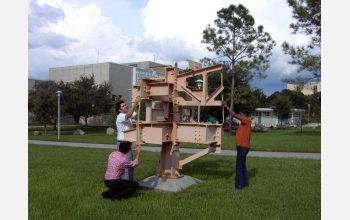|

Press Release 06-127
The Art of Engineering

Professor uses the fine arts to broaden students' engineering perspectives
September 11, 2006
On a college campus, it would be difficult to find two subjects more different from each other than art and engineering.Yet on the campus of the University of South Florida, one engineering professor responsible for teaching classes about differential equations and electromagnetism has created a popular course that merges his research world with the world of fine art.
Incorporating the works of the masters, the tools of artists and the perspective of engineers, David Snider has merged the two subjects into a single attempt to broaden the perspectives of his students and open their eyes to a world they might otherwise bypass.
"In college I avoided art classes because I felt out of place and ill prepared," said Snider, who has received a National Science Foundation grant in support of his efforts. "Later, after I had gained an appreciation for all the pleasures art can provide, I decided to design an art introduction where the technology students are empowered, rather than handicapped. The fine-art students in the class are simultaneously amused and awed by the unexpected viewpoints expressed by the techies."
Snider draws students in with topics that span from general interest--such as early theories of light and the structure of the eye--to more engineer-centric topics including a detailed exploration of the wave nature of light and the creation of cameras, from pinhole to digital.
The course, which presents nearly 100 artists ranging from Ansel Adams to Andy Warhol, even dabbles in new technologies researchers have been using to identify forgeries or determine if a work was created by a famous artist or an understudy.
"The course gives engineering students the opportunity to think more creatively about the impact of their field and the relationship between the arts and engineering," said Sue Kemnitzer, the deputy division director for education in the National Science Foundation (NSF) Division of Engineering Education and Centers. "We also expect that more students with these broader interests will be attracted to engineering careers."
In addition to hands-on laboratories where students create pinhole cameras or attempt to dissect modern technologies, the classroom side of the course uses language familiar to the engineers and reinforces engineering principles regarding optics, electromagnetism and signal processing.
"In some ways," added Snider, "my course is like an optics review, where the laboratory is the art museum."
Snider has had an impact. At the start of the course, he asks his students to identify roughly 40 artworks, and the class average is usually five or six. By the end of the semester, students are scoring 80 percent while being tested on 100 artworks from 50 artists.
"At first," said Snider, "many of the students' attitudes are coarse and unsophisticated: 'All Renaissance paintings look alike. Somebody actually paid money for this drawing?' But most of the great artists are acquired tastes, like scotch or retsina, and it's so rewarding to watch their level of sophistication and appreciation mature. I'm teaching them a new form of recreation, giving them something to do in their off time when their jobs take them to new cities."
Detailed information about the course and an extensive listing of art-related Web sites is available from Snider's homepage, linked below.
-NSF-

Media Contacts
Joshua A. Chamot, NSF (703) 292-7730 jchamot@nsf.gov
Randolph Fillmore, University of South Florida (813) 974-8476 rfillmor@admin.usf.edu
Program Contacts
Susan C. Kemnitzer, NSF (703) 292-5347 skemnitz@nsf.gov
Principal Investigators
Arthur David Snider, University of South Florida (813) 974-4785 snider@eng.usf.edu
Related Websites
David Snider's homepage: http://ee.eng.usf.edu/people/snider2.html
University of South Florida press release: http://usfnews.usf.edu/page.cfm?link=article&aid=1432

The National Science Foundation (NSF) is an independent federal agency that supports fundamental research and education across all fields of science and engineering. In fiscal year (FY) 2009, its budget is $9.5 billion, which includes $3.0 billion provided through the American Recovery and Reinvestment Act. NSF funds reach all 50 states through grants to over 1,900 universities and institutions. Each year, NSF receives about 44,400 competitive requests for funding, and makes over 11,500 new funding awards. NSF also awards over $400 million in professional and service contracts yearly.
 Get News Updates by Email Get News Updates by Email
Useful NSF Web Sites:
NSF Home Page: http://www.nsf.gov
NSF News: http://www.nsf.gov/news/
For the News Media: http://www.nsf.gov/news/newsroom.jsp
Science and Engineering Statistics: http://www.nsf.gov/statistics/
Awards Searches: http://www.nsf.gov/awardsearch/
| 





